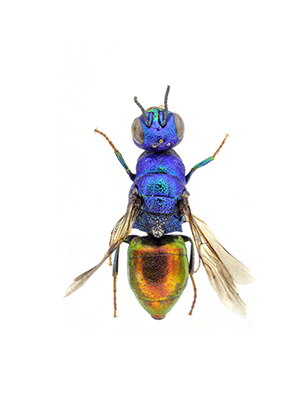Last updated on November 28th, 2023
 From: Kimsey L.S. & Bohart R.M., 1990 (1991) – The chrysidid wasps of the world. Oxford University Press, ix-652 pp.
From: Kimsey L.S. & Bohart R.M., 1990 (1991) – The chrysidid wasps of the world. Oxford University Press, ix-652 pp.
Synonymy
Elampus Spinola 1806:10. Type: Chrysis panzeri Fabricius 1804:172. Desig. by Latreille 1810:437.
Ellampus Agassiz 1846:135. Incorrect emendation for Elampus Spinola 1806.
Notozus Förster 1853:351. Type Notozus frivaldszkii Förster 1853:332 (= Chrysis panzeri Fabricius 1804). Desig. by Ashmead 1902:228.
Generic diagnosis
Facial setae scattered and erect; scapal basin nearly flat; malar space less than 1 MOD long; female with erect dense fringe of setae along gena; head generally lenticular, carinate, and angulate behind eyes; scutum and scutellum regularly and generally densely punctate; metanotum with large flat medial projection or mucro; mesopleuron strongly projecting anterolaterally, with well-developed omaulus and scrobal carina forming sharp ventral angle; fore femur with ventral carina and often sub-basally angulate; tarsal claws with 1-5 subsidiary teeth; fore wing medial vein strongly arched, arising at or slightly before cu-a, stigma short, broad, and apically rounded; T-III produced into apical, more or less membrane-filled, snout, and lateral margin sinuate; digitus and cuspis long and slender.
Distribution
This genus is found in most zoogeographic areas except the Australian and Oriental Regions. There are 8 species in North America, 3 neotropical ones, 5 African and 41 in the Palearctic Region.
Hosts
Elampus apparently parasitize ground-nesting Sphecidae. Krombein (1967) reported E. viridicyaneus on Hoplisoides costalis (Cresson). Mimesa has also been given as the host of E. panzeri by Spooner (1948), Mocsáry (1889), and Móczár (196la). Rosenheim and
Grace (1987) reared viridicyaneus from cells of Mimumesa mixta (W. Fox).
Discussion
Elampus can be distinguished by the mucronate metanotum, T-III produced into an apical snout-like structure, scutum evenly and often densely punctate, female with a short and even genal fringe, the fore wing with medial vein strongly arched, and stigma short and apically rounded.
Most closely related to the Omalus line, both have the same wing venation, the medial cell asetose, a strongly carinate mesopleuron, and posteriorly angulate head. In many species the head is almost lenticular. There are several Philoctetes that resemble Elampus, having an apical snout on T-III and a mucronate metanotum.
Elampus consists of 63 closely related species. Species distinctions are based on facial and flagellar dimensions, shape of the fore femur, and modifications of T-III. The shape of the apical snout on T-III and the extent of the apical membrane is particularly useful. Colour is important but must be used with some caution. It is not uncommon to see both green and brassy or coppery individuals in the same species. In several species, including viridis, the snout membrane is nearly circular without emargination. One species, bidens, lacks a true snout, and the apex of T-III is bent under with two submedial teeth. Several species, including guillarmodi, bidens, and scutellaris, have the fore femur strongly elbowed. Many Palearctic species tend to be bicoloured, with the head and thorax blue, green, or purple and the abdomen brassy or coppery red. In a few species, including versicolor and namibiensis, the snout membrane is red.
There is a certain amount of sexual dimorphism in this group. The most obvious difference is the genal fringe always found in females. Males only have a few long irregularly spaced setae in the same position. Females also tend to be more extremely modified than males. If the male fore femur is sub-basally elbowed in a species, the female fore femur probably has an elongate sub-basal tooth. This dimorphism has resulted in a certain amount of synonymy, with conspecific males and females given different names.
There has been no overall treatment of Elampus, only a number of regional revisions, including: North America (Bohart and Kimsey, 1982, Huber and Pengelly, 1978), Afrotropical species (Kimsey 1988a), and those of Europe (Linsenmaier 1959a, b, 1987).
European species
- Elampus albipennis (Mocsáry, 1889)
- Elampus ambiguus Dahlbom, 1845
- Elampus bidens (Förster, 1853)
- Elampus cecchiniae (Semenov, 1967)
- Elampus constrictus (Förster, 1853)
- Elampus foveatus (Mocsáry, 1914)
- Elampus konowi (Buysson, 1892)
- Elampus panzeri (Fabricius, 1804)
- Elampus panzeri coeruleus (Dahlbom, 1854)
- Elampus petri (Semenov, 1967)
- Elampus pyrosomus (Förster, 1853)
- Elampus sanzii Gogorza, 1887
- Elampus soror Mocsáry, 1889
- Elampus spina (Lepeletier, 1806)
Copyright, Authorship, and Ownership statements
All text and images of this page are copyright ©️ Chrysis.net unless otherwise stated - please see individual cases for authorship and copyright details. The specimens pictured are from the authors' or other collaborators' personal collections and from the collections of various museums. Unless otherwise specified, the whole content of this web site is for personal, non-commercial, scientific, and educational purposes given proper accreditation to the page from which they were derived are provided, and under Chrysis.net Terms and Conditions.
For citation purposes
Agnoli G.L. & Rosa P. (2025) Genus Elampus Spinola, 1806, in: Chrysis.net website. Interim version 22 April 2025, URL: https://www.chrysis.net/database/genus-elampus/.




